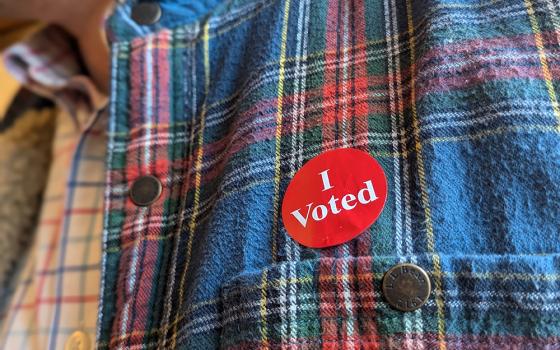
People mark their ballots at the polling place at Tysons-Pimmit Regional Library in Falls Church, Va., Oct. 31. (AP/Stephanie Scarbrough)
Editor's note: Every Tuesday, NCR columnist Michael Sean Winters sends out a newsletter to subscribers of his email list. We are publishing today's newsletter in light of Election Day. Click here to subscribe to future newsletters.
Election Day is here. All night — maybe even for a few days — we will all be focused on the granular act of counting ballots. The polls are close and the only thing we know for sure at this point is that the nation is deeply and roughly evenly divided.
The result of an election is a brute fact, a reality check for political science theories. Nevertheless, an election result is not the only political fact. Vote totals are themselves the consequence of a variety of factors, from the ups-and-downs of the campaign to tectonic shifts in national mood, to alterations in socioeconomic trends and to changing cultural values.
Writing at his Substack, "Undercurrent Events," political scientist Lee Drutman notes that, through most of the 20th century, the political parties contained ideological diversity within their coalitions, and the parties helped keep differences in check. He argues that the roots of our current polarization date back to the 1970s:
The 1970s marked the beginning of the great flattening. Activist groups began nationalizing political issues. Civil rights realigned the South. Evangelical Christians entered politics as a bloc. Gun rights became a partisan marker. Abortion turned into a party-defining stance. Issue groups and parties formed more distinct teams. Politics regionalized and nationalized around culture war issues.
Importantly, the rise of the culture wars coincided with the collapse of economic opportunity for working-class citizens in many parts of the country. Both were the soil into which the seeds of polarization were sown.
Advertisement
Nothing in democratic theory, nor in any of the explanations of the sources of polarization, explains why the country's divides shook themselves out into two, roughly equal but ever more divided partisan poles, but they did.
This will be the third election in which a few thousand votes in a few states will determine which of two wildly different governing approaches will be given power to enact themselves. "Small shifts, massive perturbations," Drutman writes. "Each oscillation brings more dramatic policy reversals and more extreme executive actions, placing greater strain on our institutions."
I understand why Joe Biden always intended to seek a second term. Political power recedes the moment someone is deemed a lame duck. But it is worth contemplating what would have happened if, instead, he had said at the start of his term that he would serve only one term, and that his one term would be dedicated to helping the country overcome some of its divisions. Might it have worked?
Most liberals' greatest fear about Donald Trump winning is that he will upend our constitutional system. I fear that also, but my deeper fear is that millions of working-class voters have been hoodwinked by Trump, and that when he fails to deliver for them, they will be yet more alienated from the institutions of governance.
If Trump loses, I do not know if Kamala Harris will be able to generate a Democratic Party capable of reconciling with more culturally conservative, working-class voters. In her closing-argument speech at the Ellipse last week, she pledged to seek national unity. If she wins, that will be her mandate and her mission, and I do have confidence that a Republican Party freed, at least somewhat, from the shadow of a defeated Trump will be willing to work for the national interest in good faith.
Maybe that is just a prayer. But it is a fine prayer.







